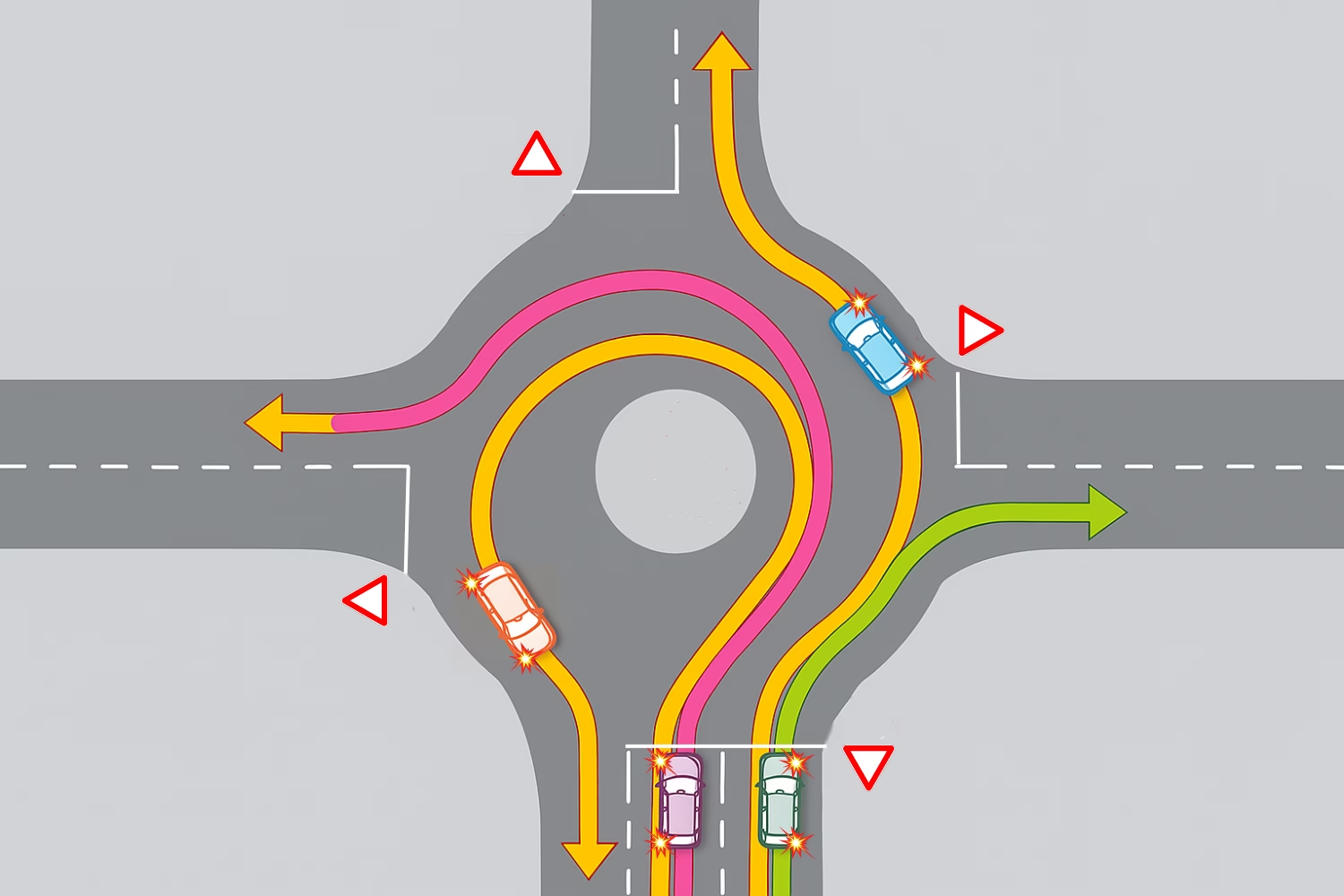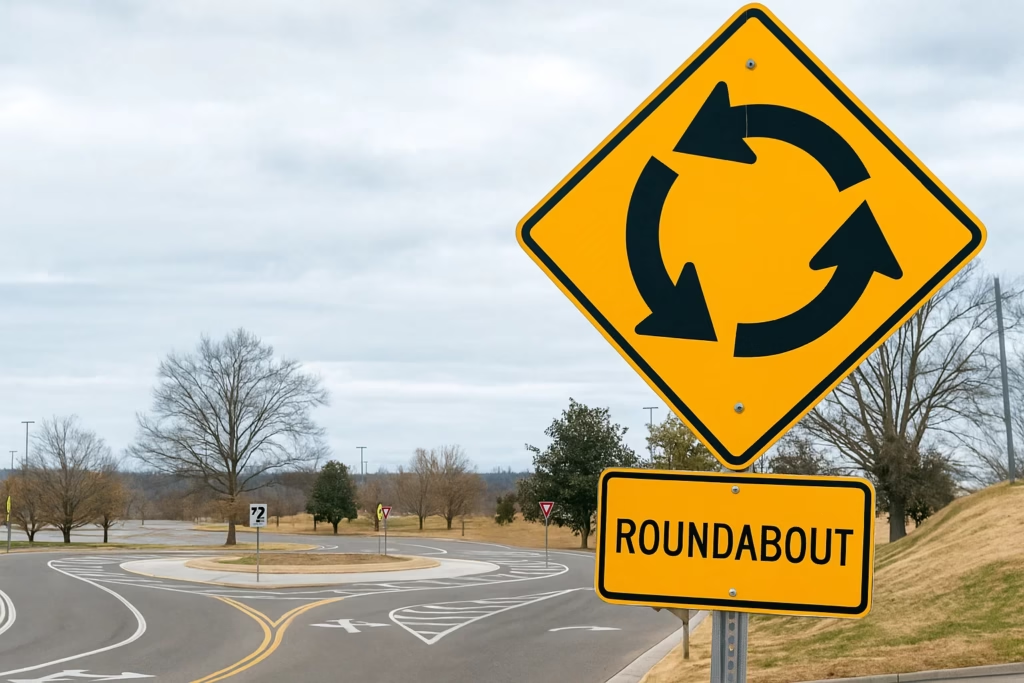Roundabouts are a common part of road systems in Europe. They are designed to keep traffic moving smoothly while reducing the risk of accidents. Unlike traditional junctions, roundabouts slow down vehicles and make drivers more aware of their surroundings. Still, many new drivers find them stressful because of the constant flow of cars. Knowing how to enter and exit a roundabout safely is an essential skill for anyone learning to drive in the EU.
What is a Roundabout?
A roundabout is a circular intersection where vehicles travel counterclockwise around a central island (in countries that drive on the right, like most of the EU). Drivers entering the roundabout must give way to vehicles already inside. The main purpose is to improve traffic flow, reduce waiting times, and lower accident risks compared to normal crossroads.
Some countries, like France, Spain, and Germany, use roundabouts widely in both cities and rural areas. The rules are generally similar across Europe, although signs and markings may vary slightly.

Preparing to Enter a Roundabout
Before reaching a roundabout, you will usually see signs and road markings warning you that one is ahead. These signs give you time to slow down and prepare.
Check the signs and road markings
Look for arrows on the road that show which lane you should use. For example, the right lane is often for turning right, while the left lane may be for going straight or turning left. Not all roundabouts have multiple lanes, but if they do, it is very important to be in the correct one.Reduce your speed
You must approach a roundabout at a controlled speed. Braking gently will keep your car stable and give you more time to observe traffic.Look to your left (in EU countries that drive on the right)
The key rule in almost all European countries is that you must give way to traffic already in the roundabout coming from your left. Never assume that other drivers will stop for you. Wait until you see a safe gap.
How to Enter a Roundabout
When you reach the entry point, the process is simple but requires full attention:
Wait for a safe gap
Be patient and do not rush. If cars are approaching from your left, you must let them pass. Once there is a clear space, move in smoothly.Keep your speed steady
Do not accelerate harshly or brake suddenly when entering. A gentle, steady movement helps other drivers predict what you are doing.Stay in your lane
If the roundabout has more than one lane, remain in the lane you chose earlier. Changing lanes inside a roundabout is dangerous and should be avoided unless road markings allow it.
Driving Inside a Roundabout
Once you are inside, keep calm and maintain your speed. Most roundabouts have a speed limit of around 20–40 km/h (depending on size and location). Do not stop in the middle unless traffic forces you to. Always keep an eye on the cars around you, especially those to your right who may want to exit.
It is also important to signal correctly. In many EU countries, you do not need to use your indicator when entering a roundabout, but you must signal when you are about to exit. This helps other drivers know your intentions.
How to Exit a Roundabout
Exiting a roundabout correctly is just as important as entering it.
Plan your exit early
Count the exits as you approach so you know where to leave. For example, if you want to take the third exit, start looking for it as soon as you enter.Use your indicator
When you are approaching your exit, signal to the right (in right-driving EU countries). This shows that you are leaving the roundabout.Check your mirrors
Before moving out, always check your mirrors and blind spots. Cyclists and motorcyclists often ride close to the edge of roundabouts, and you must make sure it is safe to exit.Exit smoothly
Do not cut across lanes when leaving. Stay in your lane and exit calmly, keeping your speed under control.

Common Mistakes to Avoid
Many accidents at roundabouts happen because drivers are unsure or careless. Here are some common errors to avoid:
Entering too quickly without checking for traffic.
Failing to use the correct lane before entering.
Not signaling when leaving the roundabout.
Cutting across lanes inside the roundabout.
Stopping inside the roundabout for no reason.
Avoiding these mistakes will make your driving smoother and safer.
Roundabout Rules in the EU
Although rules are similar across the EU, it’s always good to check the driving handbook of the country you are in. Some differences may exist in road signs or markings. However, the core principles remain the same: give way to traffic already inside, stay in your lane, and signal before exiting.
Final Thoughts
Learning how to use a roundabout properly is a vital part of driving in Europe. At first, it may seem confusing with all the cars moving around you, but with practice, you’ll find that roundabouts are actually one of the safest and most efficient traffic systems. Always remember: slow down, give way, signal clearly, and stay calm. With these rules in mind, entering and exiting a roundabout will become second nature.
Discover more from SMOOTHSTEERING
Subscribe to get the latest posts sent to your email.




Pingback: Roundabout Rules in Latvia